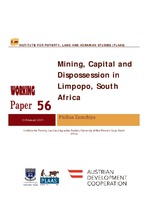Mining, capital and dispossession in Limpopo, South Africa
Abstract
This Working Paper explains the processes by which land, water and other natural resources were seized, and their previous users dispossessed, for the purposes of capital accumulation by Ivanplats platinum mining company in Limpopo, South Africa. The mining firm largely acquired land through non-voluntary mechanisms by disregarding South Africa’s Interim Protection of Informal Land Rights Act (IPILRA) set to protect the lawful occupiers and users of land. Through detailed empirical examination, I demonstrate how locals in Limpopo experienced dispossession through enclosure of farmland, water sources, grazing fields and cultural shrines, paving the way for accumulation by the mining firm. Beyond productive sources, the mining firm also acquired capital through imposing financial interests on unfair community loans. Corruption, coercion and bribes were useful dispossession tools in a powerful triple alliance of investors, state officials and traditional leaders. This exacerbated the crises of livelihoods for many, especially women, who did not integrate in the new mining wage-labour economy and its entrepreneurial opportunities. I partly agree with scholars who have used some Accumulation by Dispossession (ABD) features to explain this phenomenon. However, it is important to note that dispossession even through economic means and with voluntary consent can also lead to similar dire consequences for the rural poor. In addition, the farmers were not out of capitalist relations of production as implied in the conceptualisation of ABD with its genealogy in primitive accumulation and there was no full rural proletarianisation. Given the nominal welfarist benefits for the locals in this extractivist model of investment, covert, intermediary and overt resistance to land dispossession was rife, though it met with brutal state force making the future unstable and uncertain

